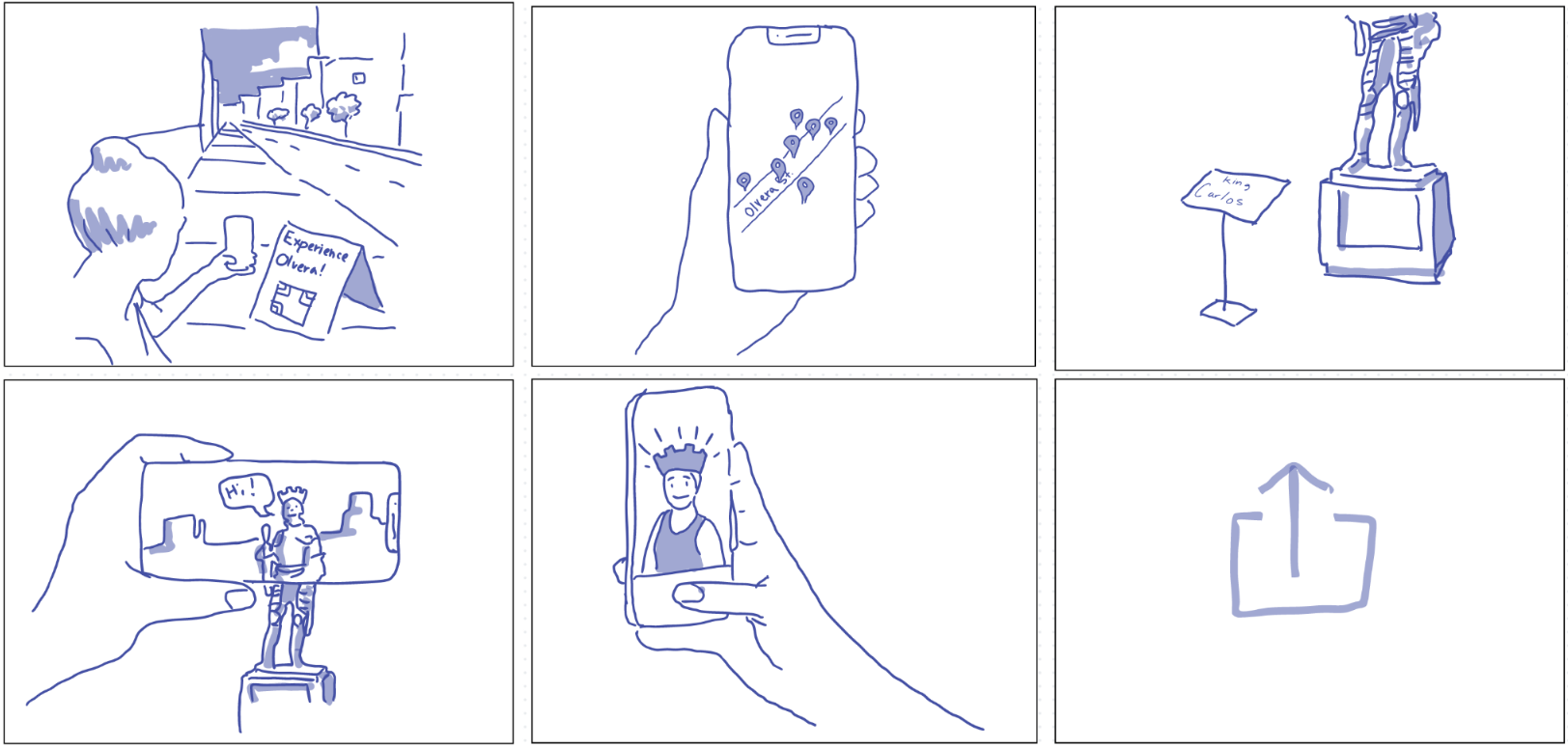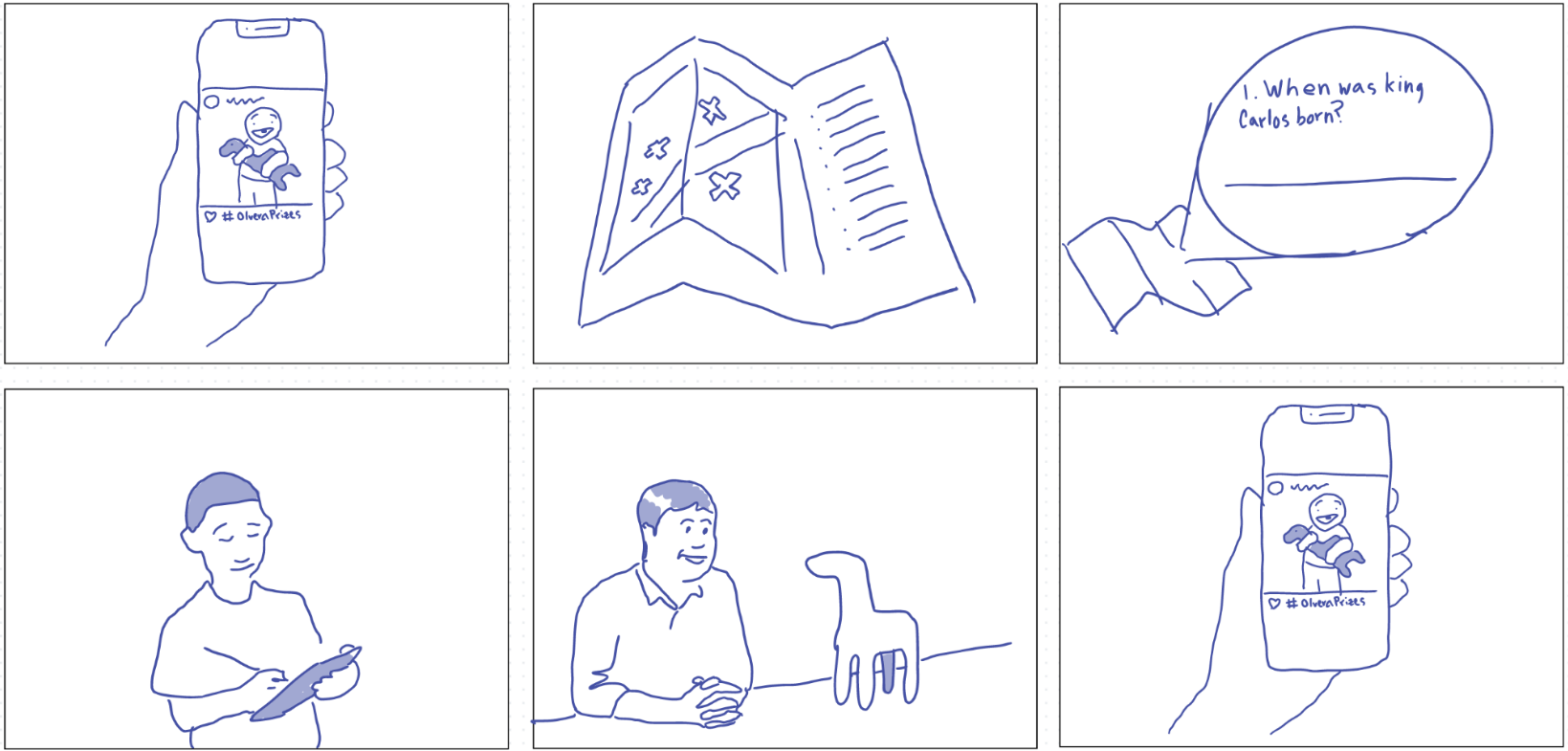Final UI Concept
Overview
IxD Studio 1 - Fall 2023 - 16 Weeks
CLIENT:
Student Project for Interaction Design Course
PROCESS:
Target User Interviews, Empathy Maps, Storyboard, User Flows, Low-Fidelity Prototype, User Testing, High Fidelity Prototype
ROLE:
Researcher, Interviewer, Designer
OUR DESIGN GOAL
Increase foot traffic at Olvera Street through LA transplants who want to explore.
Problem, Insight, Solution
Olvera Street vendors are struggling to stay afloat after the effects of Covid-19 caused a large drop in foot traffic. The closure of attractions around Olvera threatens the local vendors who rely on consistent foot traffic. This led to the insight that Olvera Street attracts tourists and recurring visitors through personal connections to the area. This along with lingering concerns about Covid-19 mean that visitors are looking for safe outdoor activities to do with friends. Our solution is to bring Olvera's rich history back to life through interactive AR experiences while boosting the social media presence of Olvera Street by encouraging visitors to share their experiences for rewards.
Post COVID-19 Olvera Street
How might we design an interactive experience to increase foot traffic at Olvera Street to support vendors?
Field & Desktop Research
After concluding multiple rounds of field and desktop research, we noticed a few unfortunate realities. Firstly, there is a significant gap in visitor awareness regarding the cultural and historical attractions at Olvera. Next, many vendors have faced economic hardships due to shop closures. Finally, an absence of enticing attractions that actively draw people to the historical sites around Olvera. Knowing about these issues would give us direction for our design decisions.
Barren Town Center on a Weekend
User Interviews
We finalized our research by conducting interviews with people around Olvera. We aimed to get a variety of people including locals, international travelers, and vendors. From these interviews, we were able to get inside information about how Covid-19 affected Olvera Street. The visitors revealed that the museums are not well-known and hidden in plain sight. They also mentioned how they returned to Olvera because of personal ties from their childhood, along with a persisting fear of Covid-19 in such a public environment. For the vendors, they emphasized the impact Covid had on business due to the lack of people. Business was also impacted by the closure of a massive restaurant nearby "La Golondrina."
Interview Guide Used
Creating a User Persona
Now that we have a problem to solve and an understanding of who we are solving for, we created our user persona "Jessica" to guide our design process. Jessica is a 26-year-old college student in Los Angeles who is originally from Indiana. She is single and enjoys exploring the city on the weekends. She loves to share her experiences on social media and has nieces from L.A. who visit her. Her interests are in history and culture, she is attached to her phone, comfortable with new technology, and loves trying new foods.
Representation of Jessica
Storyboarding
During the ideation and storyboarding of our AR journey, we had to ask ourselves a couple of questions:
Who is it for?
What problem does it solve?
Why might it fail?
What can we prototype and test?
How might we measure success?
This led us to create a paper prototype of our concept and begin receiving feedback.


Paper Prototyping
We created and tested our concept through paper prototyping which allowed us to see how our product would interact in a real-world scenario.
DIGITAL PROTOTYPE
Using our feedback during the paper prototyping phase, we brought Discover Olvera to life through a digital, mid-fidelity prototype.
Final Product
With our last round of feedback, we refined and cleaned up the digital prototype resulting in a functional experience. Try it out!
Interactive Map
The home screen of Discover Olvera is an interactive map that includes information on nearby museums, restaurants, and AR experiences. Each location on the map will provide information on current times, contact, history, and direction to guide the user.
AR Experience
Each AR experience can be found through the interactive map. These experiences are tied to physical locations around Olvera Street. Each experience aims to teach the user a little more about the history of that location.
Sharing Rewards
Once a user finishes an AR experience, they are prompted to share their experience through social media. If they choose to do so, a new reward will unlock allowing them to play with filters and other AR characters at home.
REFLECTION
Working with my design team on Discover Olvera has truly been an eye-opening experience that gave me insights into real-world tasks and the process of designing a product. This project utilized and refined my problem-solving skills by taking me diligently through the process of discovering a problem and creating creative solutions. These solutions showed me the importance of user-centric designs. We had created a target audience and had to interview a specific demographic and change our product solution based on the feedback we received. This, along with being placed in a tight time restriction of 16 weeks pushed me to manage my time along with the time of my team. Finally, this project introduced me to the world of AR and the technical challenges behind using technology as a solution to a physical problem.